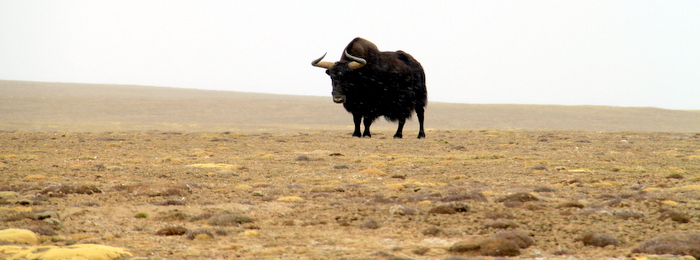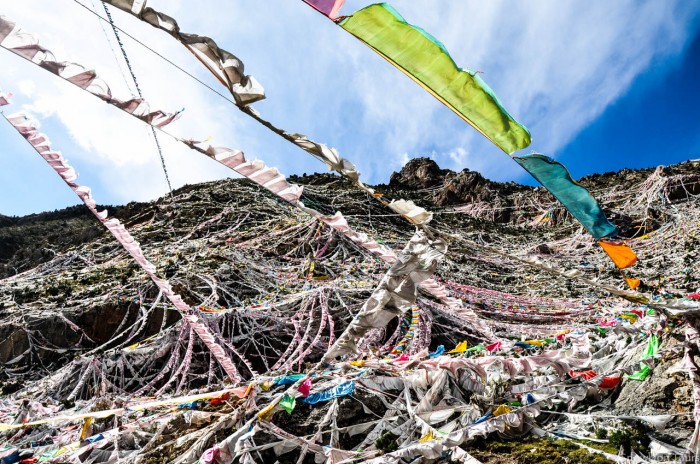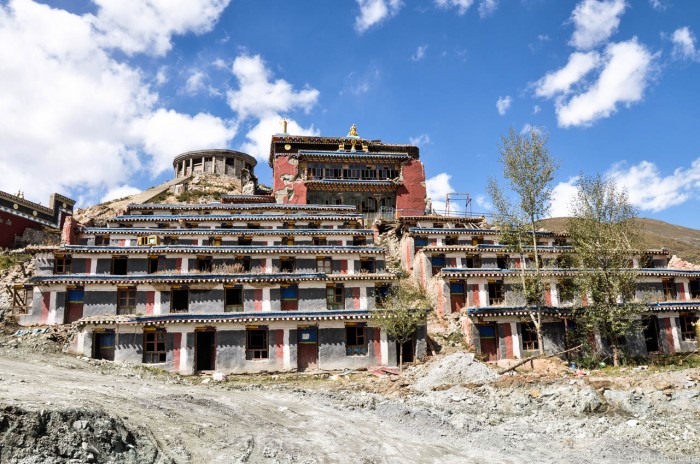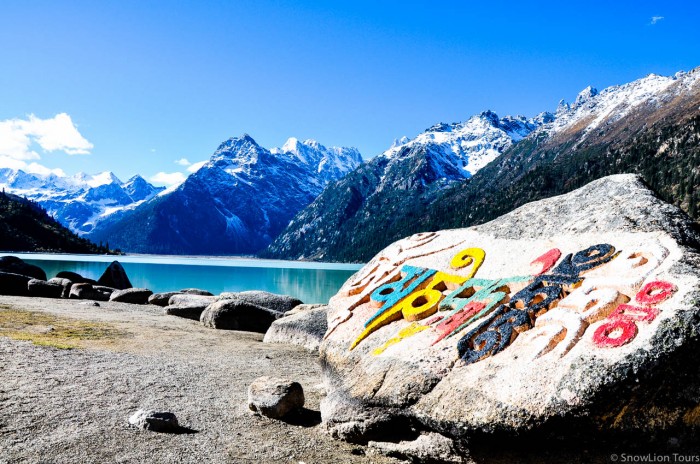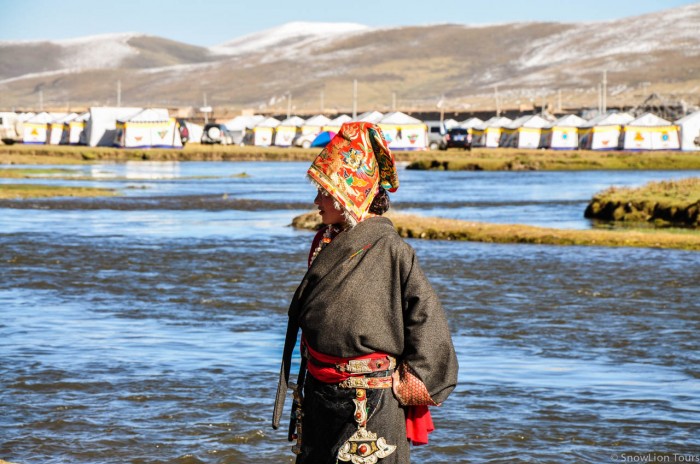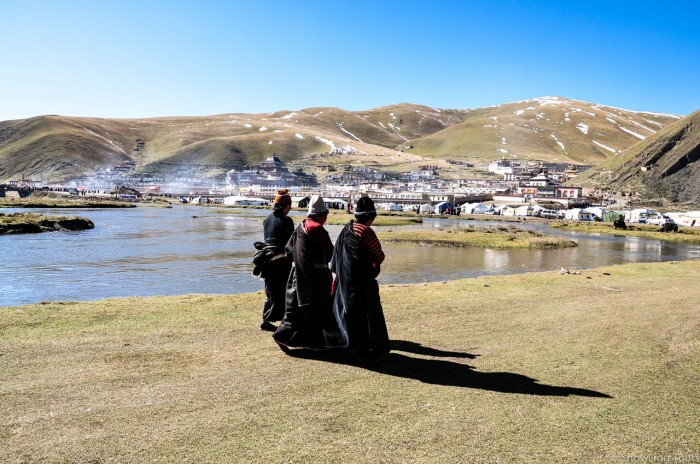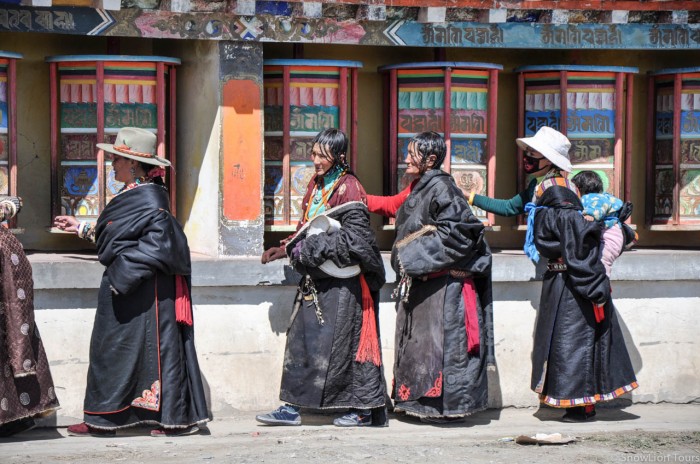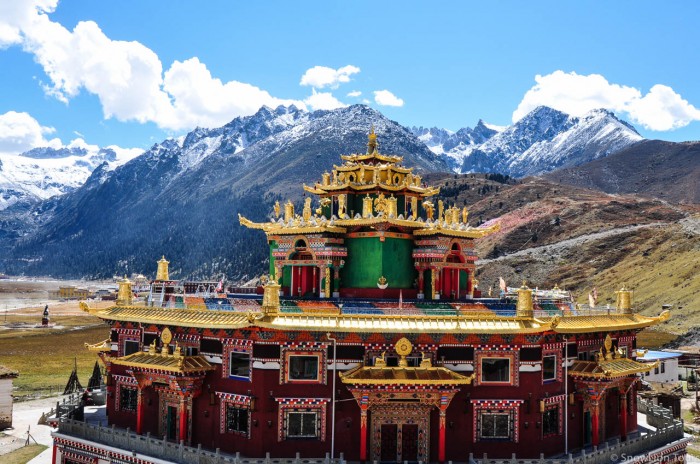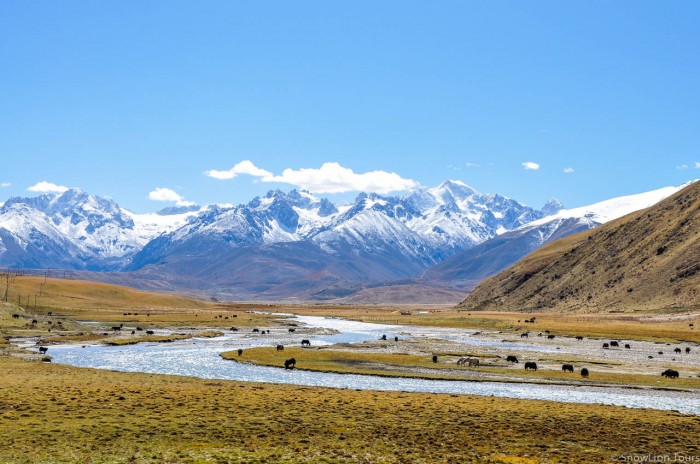Day 1: Xining – Kumbum Monastery (Ta’er si) – Qinghai Lake (KokoNor) [3196m]
Drive to Kumbum, a famous monastery outside of Xining. Kumbum is founded in 1427 and home to over 600 monks. This is the hometown of great master Je Tsongkhapa who is the founder of Gelupa lineage in Tibetan Buddhism. Both 10th Penchen Lama and 14th Dalai Lama have studied in this monastery when they were young. Yak butter made sculptures, frescoes and padded embroidery are the three treasures of the monestery. There are some great hills around the monastery to hike. From Kumbum, head to Qinghai Lake, the biggest lake in China. Stay at a hotel or guesthouse on the shores of the lake.
Day 2: Qinghai Lake – Dredzong Monastery [3200m]
Take pictures of the blooming yellow flowers along the shores of Qinghai lake and visit the nomads herding yaks and sheep. Drive to Dredzong Monastery and stay nearby. Dredzong means “the land of monkeys”. It’s located in an open valley on a hillside. There are several temples you can visit such as the assembly Hall, Guardians Hall, Future Buddha hall, Tara Hall.etc. After visiting the temple, if you want to take 3 hours trek, you can go around Monastery along the pilgrimage path. Stay in Dredzong or Xinghai.
Day 3: Dredzong Monastery – Jyekundo (Yushu) [3710m]
Drive through some of the remote areas of Tibetan Plateau. You can see yak hair and white nomadic tents and their yaks and sheep scattering on the leisurely grassland. Continue on to Jyekundo, a large town populated almost entirely by Tibetans.
Day 4: Jyekundo [3710m]
There are many famous sites around Jyekundo, including a picturesque local monastery and an enormous pile of carved stones featuring Tibetan prayers. Today, 2 main sights are Jyekun (Jiegu) Monastery located behind the town and Gyanak Mani Stone (cn:Jiana manishi) which earned the fame of largest mani stone in the world.
Day 5: Jyekundo [3710m]
Drive to Binang valley to see The Princes Wenchen Temple which is founded in 7th century. Spend the rest day hiking, bartering in the Tibetan market, eating traditional food, and visiting nearby sites like a white stupa at the edge of town.
Day 6: Jyekundo – Sershul (Shiqu) Monastery [4200m]
Visit Sershul Gompa, a monastery and meditation center.
This is an important Nyinmapa and Gelupa monastery lies on the beautiful hillside. This is the biggest monastery in Sershul area which hosts more than 500 monks at the present. There were 1500monks in it’s peak in 19th century. This monastery annually holds Molam Festival or Prayer Festival and Buddhist teachings by the head of this Monastery in October. This is great time to visit this monastery, the monastery offers tents, blankets, food, tea for free for anyone comes from outside. You will see many Tibetan nomads from Jyekundo(Yushu), Dege, Nagchu in Tibetan Autonomous Region to attend this week long Prayer Festival.
Day 7: Sershul – Dzogchen Monastery – Manigango [4180m]
Drive from Sershul Monastery to Sershul town which is a small trading town, continuing drive through some beautiful open valleys with covered by yaks, you will reach the famous Dzochen retreat center. Dzochen Monastery is recognized as the major pilgrimage site of Tibetan Buddhist in the eastern Tibet and as one of the largest Monasteries of Nyingmapa school in Kham region. The monastery is founded by Fist Dzochen Pema Rigzen in late 16th century on the advice of the Fifth Dalai Lama. Later expended by his students, including Drichen Rabjam, Tenpei Gigme and by his successive incarnations. Dzochen tradition is one of the most popular practice in the west. The night in Manigango, a small trading town for nomads.
Day 8: Manigango – Yilhun Lhatso Lake (XingXinghai)-Dege [3270m]
Visit the beautiful lake Yihun Lhatso, a place that locals consider holy. You can see many Mani Stones (Sutra prayers carved on the stone) with different colors on the shore. This crystal clear lake is surrounded by snow capped mountain. After spend few hours at the lake, continue on to the famous Chola Mountain 6168m. Drive over the mountain pass at 5000m and then down to Dege.
Day 9: Dege/ Derge
Visit the DegeParkhang Printing House, one of the most important Buddhist scripture printing houses. Discover manual printing, which is done with carved wood blocks. The king Tenpa Tsering brought Dege to the peak of it’s power by conquering the outlying northern districts of Dzachuka. Under his instructions and assistant from local tribes, Dege Parkhang/ Dege Printing House was founded in 1729. There are total of 217.000 wooden printing blocks housed in the this printing house and the works of this print house has been used all cross Tibet Plateau. Afterwards, visit Dege Gomchen Monastery which was founded in 1448, the monastery originally built as a Sakyapa Monastery, therefore, it has kept strong ties with Sakyapa and the center of Ngor Gompa. You can distinguish the Sakyapa lineage by checking the purple color with white stripes. Stay in Dege.
Day 10: Dege-Pelyul (Baiyu) [3040m]
Driving along the Yangtse River you will reach the border of Sichuan and Tibet Autonomous Region. Take shift to left continue drive through some deep valley and forests, you will reach Baiyu (Pelyul) county. The Pelyul Monastery was founded in 1665 in the Kham province of eastern Tibet (present-day Baiyu, Sichuan, China) by Kunzang Sherab, the First Palyul Throne Holder. Stay in Pelyul.
If you have one more day, you can take a detour to some other Monastery like Palpung Monastery (Babangsi), a Karma Kagyupa’s monastery established by Taisitu Rinpoche in 1727, and Katok Dorjeden Monastery, one of the oldest Nyingmapa monasteries in Tibet.
Day 11: Pelyul – Garze (Ganzi) [3394m]
The drive from Pelyul to Garze provides great view of mountains, rivers, forests and grasslands. Yaks and sheep can be seen along the way. Garze is a small trading town where Tibetan people from surrounding areas such as Dege, Nyarong, Pelyul and Amdo come to buy goods. Visit Garze Monastery, which was originally built in 1642.
Day 12: Garze – Litang (4200m)
Surrounded by deep green hills and plains, snowcapped peaks, and fortress-like Tibetan homes at the center of the Ganzi Tibetan Autonomous Prefecture, Litang is one of the highest elevated towns in China. The Litang Monastery, is located on the north side of the town, was built by the 3rd Dalai Lama Sonam Gyatso. Litang is famous for being the birthplace of 7th and 10th Dalai Lamas.
Day 13: Litang – Lhagong (Tagong)[3730m]
Check out the fantastic view of Lhagong Monastery, where there are many chortens (stupas). Circuit the chortens and temples with local pilgrims and take pictures of the spectacular chorten on the hillside above the road, where pilgrims enter the monastery grounds.
Day 14: Lhagong to Dartsedo (Kangding) [2616m]
The mid-sized town of Dartsedo is the capital of the Ganzi Prefecture. Though much of Dartsedo has been urbanized, it is possible to visit a few monasteries around town and catch great views of snow-capped mountains in the distance.
Day 15: Dartsedo – Danba [1935m]
Danba is the home of the Gyarong Tibetans, a Tibetan tribe slightly different from those of other Tibetan regions. Visit some of the rock-made houses scattered on the slopes of mountains. Gyarong Tibetans’ dress is unique; though most men wear casual clothes, the women still wear colorful embroidered headscarves and elaborate belts and aprons.
Day 16: Danba-Chengdu [500m]
Day 17: Depart Chengdu
Your driver will drop you off at the Chengdu airport.
Itineraries are subject to change without prior notice.




